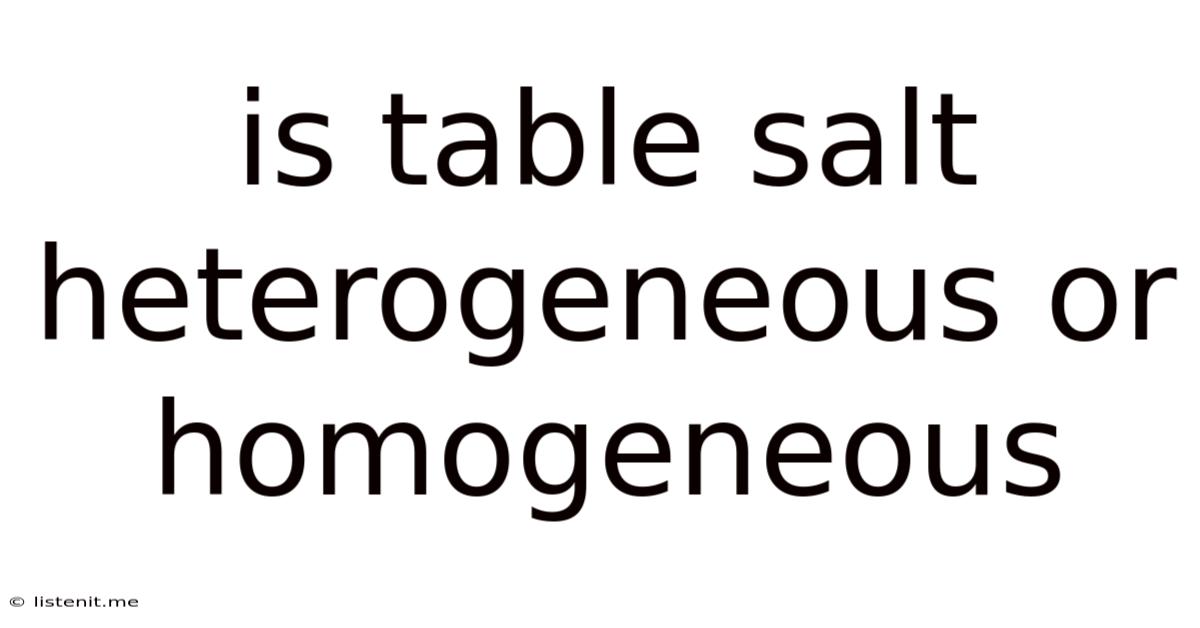Is Table Salt Heterogeneous Or Homogeneous
listenit
May 12, 2025 · 5 min read

Table of Contents
Is Table Salt Heterogeneous or Homogeneous? A Deep Dive into Mixtures
The seemingly simple question of whether table salt is heterogeneous or homogeneous opens a fascinating door into the world of chemistry and the properties of matter. While the answer might appear straightforward at first glance, a closer examination reveals a more nuanced understanding of mixtures and their classifications. This article delves deep into the nature of table salt, exploring its composition, structure, and behavior to definitively answer this question and illuminate the underlying scientific principles.
Understanding Homogeneous and Heterogeneous Mixtures
Before we dive into the specifics of table salt, let's clarify the definitions of homogeneous and heterogeneous mixtures. These terms describe the uniformity of a mixture at a microscopic level.
Homogeneous Mixture: A homogeneous mixture is one where the components are uniformly distributed throughout the sample. No matter where you take a sample from the mixture, the composition will be identical. Think of saltwater: the salt dissolves completely into the water, resulting in a uniform solution. You can't visually distinguish the salt from the water.
Heterogeneous Mixture: A heterogeneous mixture is one where the components are not uniformly distributed. Different regions of the mixture have different compositions. Think of sand and water: you can clearly see distinct sand particles dispersed in the water. The composition varies depending on the location of the sample.
The Composition of Table Salt
Table salt, chemically known as sodium chloride (NaCl), is primarily composed of two elements: sodium (Na) and chlorine (Cl). These elements combine through an ionic bond, forming a crystalline structure. However, pure NaCl is rarely found in nature. Commercial table salt often contains additives to improve its flowability, prevent clumping, and add iodine for nutritional purposes. These additives are crucial to consider when determining the homogeneity of the final product.
Pure Sodium Chloride: A Homogeneous Substance
Pure sodium chloride, in its crystalline form, is considered a homogeneous substance. At the microscopic level, the sodium and chloride ions are arranged in a highly ordered, repeating three-dimensional lattice structure. This structure is consistent throughout the entire crystal. Regardless of where you sample from a single crystal of NaCl, the ratio of sodium to chloride ions will be 1:1, reflecting the chemical formula. This uniformity is the hallmark of a homogeneous substance.
Table Salt: A More Complex Picture
The situation becomes more intricate when we consider commercially produced table salt. While the majority of table salt is NaCl, manufacturers typically add other components to enhance its quality and functionality. These additions include:
- Anti-caking agents: These substances, like silicon dioxide (SiO2), prevent clumping by absorbing moisture.
- Iodine: Iodine is added to combat iodine deficiency, a prevalent health issue in many parts of the world.
- Other minerals: Traces of other minerals might be present depending on the source of the salt.
These additives are generally present in much smaller quantities than NaCl. However, their presence impacts the homogeneity of the mixture. The anti-caking agents, for example, may not be perfectly distributed throughout the salt crystals, creating small regions with varying compositions. The iodine, similarly, may not be uniformly dispersed at a microscopic level, though it's often incorporated into the crystal structure during production.
Determining the Homogeneity of Table Salt
Determining whether table salt is homogeneous or heterogeneous depends on the scale of observation and the purity of the sample.
Microscopic Scale: At a microscopic level, examining individual crystals of NaCl reveals a homogeneous structure. However, if we zoom out, the presence of additives like anti-caking agents can introduce heterogeneity. These additives create regions with a slightly different composition compared to the surrounding NaCl crystals.
Macroscopic Scale: At a macroscopic scale—the level we typically interact with table salt—it appears homogeneous. The additives are present in such small quantities that their effect on the overall composition is negligible for most practical purposes. You cannot visually distinguish different components in a spoonful of table salt.
Therefore, the answer to the question depends on the level of scrutiny.
-
Strictly speaking, table salt is a heterogeneous mixture due to the presence of additives and the potential for non-uniform distribution of these additives.
-
For most practical purposes, table salt can be considered homogeneous. The additives are present in such small amounts that their influence on the overall properties is insignificant. The macroscopic uniformity is what dictates its functionality in everyday cooking and other applications.
The Importance of Scale in Mixture Classification
This discussion highlights the crucial role of scale in determining whether a mixture is homogeneous or heterogeneous. Many materials appear homogeneous at a macroscopic level but reveal heterogeneity when examined at a microscopic or nanoscopic scale. The context of the observation is critical in determining the appropriate classification.
Conclusion: A Nuanced Answer
The question of whether table salt is homogeneous or heterogeneous has a nuanced answer. While pure NaCl is undoubtedly homogeneous, commercial table salt contains additives that introduce a degree of heterogeneity at a microscopic level. However, at the macroscopic scale, the practical properties of table salt are effectively uniform. Understanding this distinction requires considering both the composition and the scale of observation. This example illustrates the importance of precise terminology and careful consideration of the scale when classifying mixtures in chemistry and related fields. The seemingly simple question of table salt's nature opens up a fascinating discussion about the complexities of matter and the subtle distinctions between different types of mixtures.
Latest Posts
Related Post
Thank you for visiting our website which covers about Is Table Salt Heterogeneous Or Homogeneous . We hope the information provided has been useful to you. Feel free to contact us if you have any questions or need further assistance. See you next time and don't miss to bookmark.